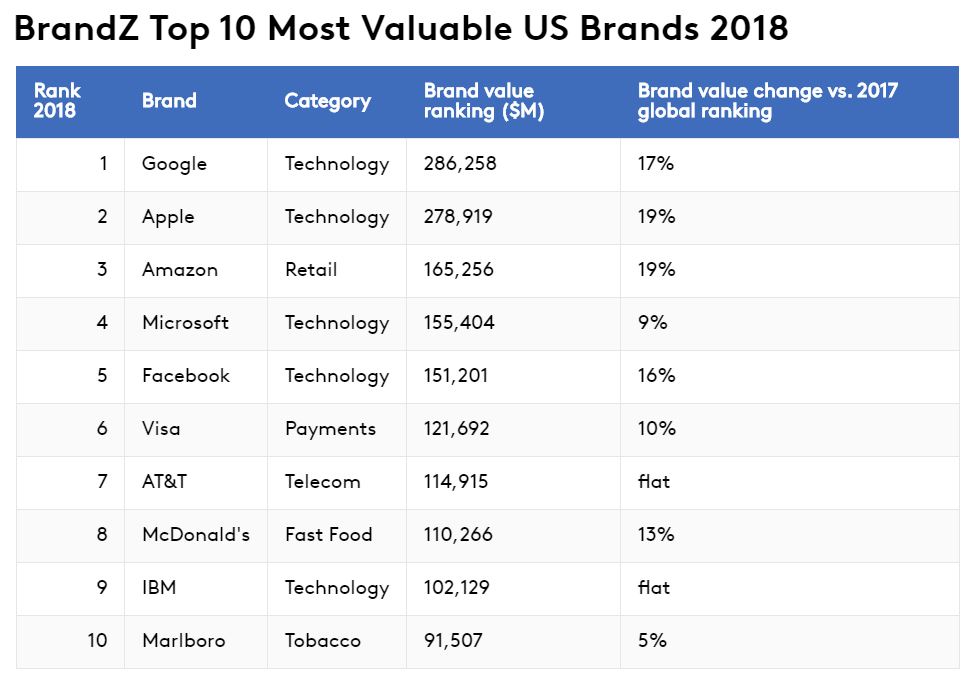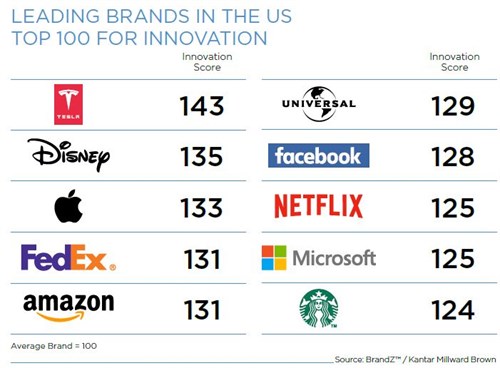Technology leaders Google, Apple, Amazon, Microsoft and Facebook topped the first BrandZTM Top 100 Most Valuable U.S. Brands ranking released today by WPP and Kantar. And while many Americans may be distracted by a volatile political climate, the Top U.S. Brands remain focused on purpose, innovation, and delivering a unique brand experience to both U.S. and global consumers.
Google’s value, driven by strong purpose and customer experience, increased 17% to $286 billion, compared with the 2017 BrandZ Global Top 100 ranking published in June. At number two, Apple, the most meaningfully different brand in the ranking, grew 19% to $279 billion during the same period. Amazon, driven by strong brand experience, jumped one spot to number three compared with the 2017 Global report, growing 19% to $165 billion. When compared with the initial BrandZ ranking in 2006, Amazon’s growth tops the chart at 2,662%.

The U.S. Top 100 brand value totaled $3.16 trillion, with the Top 10 brands accounting for half of the total. U.S. brands dominate globally, with 54 ranked in the 2017 Global Top 100. Overall, technology brands accounted for 19 of the U.S. Top 100 and $1.2 trillion, or more than one-third of the total value.
While tech brands dominate the top of the brand valuation ranking, the U.S. report explores a number of categories that include iconic and strong American brands. Many of these have a global presence but are particularly strong in their home country, including airline, packaged goods, hotel, retail, insurance, fast food and local telecommunications brands. In fact, when looking purely at Brand Contribution, a BrandZ metric that looks specifically at how well a brand differentiates itself, generates desire and cultivates loyalty, Pampers, Estee Lauder, Coca-Cola, Huggies and Tide top the list, demonstrating that Americans have room in their hearts and minds for more than tech.
U.S. brands aren’t without competitive threats, though. While the Top 100 brands in China, the world’s second-largest economy, have a total brand value of $557 billion, or only one-sixth of the value of U.S. brands, Chinese brands, led by Tencent, are growing rapidly and innovating for an increasingly sophisticated Chinese and global consumer.
“While America is in the midst of a volatile, unique political period, U.S. brands remain focused and continue to thrive,” said David Roth, CEO EMEA and Asia, The Store WPP. “With brands ranging in age from just 18 months to more than 200 years old, the rankings demonstrate that savvy U.S. consumers will reward brands that evolve and deliver meaning over time, while also welcoming innovative challenger and transformational brands.”

“U.S. brands are among the most iconic and valuable in the world, and they are also the target of every brand from both abroad and the vibrant start-up world,” said Tim Wragg, CEO, Kantar, Insights, North America. “Successful brands remain healthy over time when they build brand love via clear purpose, continual innovation, effective communication and a laser focus on customer experience. Sophisticated American consumers continue to set a high bar for U.S. brands, providing them with a strong platform for domestic and global success.”
The BrandZ U.S. Top 100 report also includes new research from Y&R’s BAV Group, which examines what it takes to build powerful nation brands. According to BAV Group’s 2017 Best Countries report, the U.S. ranks seventh best overall out of 80 countries, and scores particularly high on power, connection to the rest of the world, being forward thinking, cultural influence and entrepreneurship. Top 100 U.S. Brands including McDonalds and Starbucks are among ambassador brands that represent “Brand U.S.” abroad, while adapting to local preferences, showing both boldness and sensitivity, the hallmarks of a modern U.S. brand.
Key trends highlighted in the BrandZ U.S. Top 100 study include:
- Meaningful Difference always makes the difference:With a score of 187 (100 is the average), Apple delivers the most meaningful difference. But even in the challenging airline category, brands can deliver meaning. Southwest Airlines (number 74 at $8.1 billion), known for its quirky ads, its authentic social media engagement and its sponsorship that helps military veterans travel to war memorials, scored 149 on meaningful difference.
- U.S. consumers have high standards with regard to brands and data:The American consumer is one of the most sophisticated in the world and expects better service in exchange for the data they share. Consumers no longer accept being lumped into a gender/age bracket and will quickly disengage with brands that don’t show relevance.
- Going asset-light pays off heavily:Technology and services are transforming a traditionally product-first society into one where many brands are going “asset-light,” no longer owning the full value chain and sometimes not any part of it. Instead, they focus on brokering the final product, offering services or value in other ways to improve the customer experience.
- Brand Experience makes or breaks brands:Americans place a high premium on time and show loyalty to brands that deliver a thoughtful, fulfilling brand experience. FedEx and Amazon rank first and second for brand experience as, often together, they offer selection, convenience and speed in the online shopping experience.
- Get out of the bubble:The American brand world can be highly insular, with marketers, agencies, and employees often sharing a narrow, largely urban worldview. For example, New Yorkers likely have more in common with Londoners than they have with Midwesterners. The result is people feeling that brands may not be interested in their business. Marketers need to understand and connect with real consumers across their entire geography, or risk losing ground to more in-touch competitors.
- The Silicon Valley mind-set continues to influence the U.S. and the world:American companies and workers are among the most innovative in the world, and show no signs of slowing down. The innovation demonstrated by the Top 100 brands is evident, while transformative businesses are challenging brands, companies and markets. From Airbnb to Uber, Lyft and WeWork, Americans are rethinking how they work, travel, engage and live.
The BrandZ Top 100 Most Valuable U.S. Brands report and ranking, as well as other brand insights for key regions of the world and 12 market sectors, are available online here. The reports, rankings, charts, articles and more can also be accessed through the BrandZ app, which is free to download for Apple IOS and all Android devices from http://www.brandz.com/mobile or by searching for BrandZ in the iTunes or Google Play app stores.
Editors notes
The valuation behind the BrandZ™ Top 100 Most Valuable U.S. Brands was conducted by Kantar, which specializes in brand equity research and brand valuation. The methodology mirrors that used to calculate the annual BrandZ Top 100 Most Valuable Global Brands ranking, now in its 12th year.
The BrandZ Top 100 Most Valuable U.S. Brands is the most definitive and robust ranking of the country’s brands available, and thebrands ranked all meet these eligibility criteria:
- They were originally created in the U.S.
- The brand is owned by a publicly traded enterprise, or its financials are published in the public domain
- For telecom providers, the brand is owned by a U.S.-listed company and mainly operates in the U.S.
This approach produced a carefully conceived ranking of brands in 22 consumer-facing and business-to-business categories, including technology, telecom, retail, banks, food, cars and airlines.

